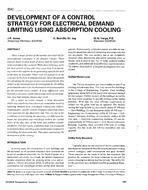Description
Often a major proportion of the monthly electrical bill for nonresidential consumers is for demand charges. These charges relate to peak levels of power that the utility must make available to the customer. While these levels may occur for short periods of time only, they cause long-term operating costs to the supplier as the generating capacity for such levels must be available. These costs are passed on to the customer in the form of demand charges. Often the formula for calculating the charges involves two demand levels. One relates to the maximum level of consumption for the billing period and the other is for the maximum level of consumption for the previous twelve months. If large differences exist between consumer’s peak and average levels of consumption, very high demand charges may result. On a major university campus, a large absorption chiller was installed to limit electrical consumption levels by offsetting demand from centrifugal compression chillers. Unfortunately, specific control strategies (start/stop times) were uncertain for the absorption unit. This was due to the complexity in determining the operating cost difference between the absorption and centrifugal chillers for various hours of the day, days of the week, and ambient weather conditions. For this reason, a detailed study was conducted to determine these operating costs and develop a strategy for controlling the absorption unit. Summarises the development of this strategy.
KEYWORDS: load management, absorption refrigeration, universities, electricity consumption, energy conservation, centrifugal compressors, controls, operations, costs.
Citation: ASHRAE Transactions 1993, Vol.99, pt.1
Product Details
- Published:
- 1993
- Number of Pages:
- 8
- File Size:
- 1 file , 960 KB
- Product Code(s):
- D-17640




